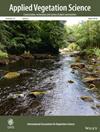EcoFloVCS: An eco-physiognomic-floristic vegetation classification system
Abstract
Background
Vegetation science research has been conducted for approximately 200 years; however, until now there has not been a unified classification principle or system that was acceptable to vegetation scientists. To facilitate the development of vegetation science and its applications in natural conservation, a unified vegetation classification system is urgently required. Here we propose a unified eco-physiognomic-floristic vegetation classification system (EcoFloVCS) that combines eco-physiognomic and floristic characteristic classification systems.
Methods
Under the EcoFloVCS, plant communities are considered to have six key components (species composition, structure, habitat, development, locality, and function). Six associated characteristics are derived from these six components (dominant species, diagnostic species, physiognomy, distribution patterns, dynamics, and disturbance processes). These characteristics are used as the basis for community classification.
Results and Conclusions
The high-level units of this system agree with the UNESCO system, whereas the middle- and low-level units correspond to the Braun-Blanquet classification system. Both are connected by a Division (Subformation) unit. Based on the EcoFloVCS, a vegetation system was constructed for the four highest units worldwide that included seven Formation Classes, 22 Formation Subclasses, 39 Formation Groups, and 119 Formations. We assume that vegetation science will benefit from our unified EcoFloVCS through comparing and understanding community structures and functions on a global scale.


 求助内容:
求助内容: 应助结果提醒方式:
应助结果提醒方式:


